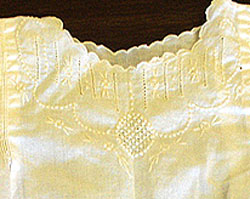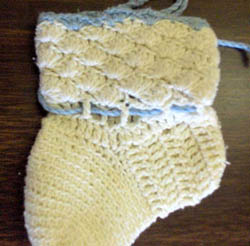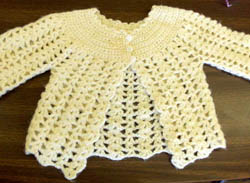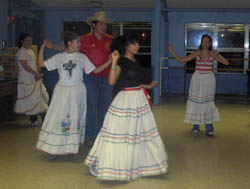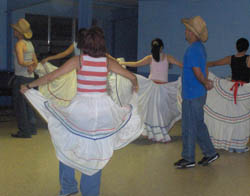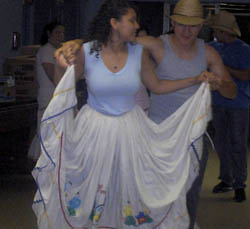Honduran Identity within South Louisiana Culture
By Denese Neu
Honduras and New Orleans: an Economic and Social Relationship
The connection between New Orleans and Honduras is more than a century long. Many of the early immigrants came to the region as employees of the United Fruit Company. Headquartered in New Orleans, the company was a major land holder and employer in Honduras. During the peak years, the company dominated the country by owning/controlling 650,000 acres and much of the transportation infrastructure. Bananas comprised 88% of the country's exports, and the company employed more than 100,000 persons in Latin America; 90% of which were Latin Americans. The bananas arrived in the United States through the Port of New Orleans.
As the largest employer in the predominately agriculture-based economy, they also provided free medical care, housing, and schooling. Because of this presence, this New Orleans company had significant economic and social impact on the country and people of Honduras. Many children of United Fruit workers were granted educational visas and came to New Orleans for schooling. Some older New Orleanians recall attending classes with these students who were housed on the campuses of some of the private Catholic schools. Some children returned to Honduras but many chose to stay upon graduation and settled permanently in the New Orleans area. Honduran adults also came to New Orleans for medical treatment and in service jobs for the executives of the company. Others were recruited to work in positions that required bilingual skills. Many of these individuals also chose to remain in the city rather than return to their country of origin. Thus, a strong social pipeline was created between the two places. Today, the links between Honduras and New Orleans remain strong despite the fact that the import company's headquarters left New Orleans in 1985 when it became Chiquita Brands.
Some Honduran immigrants say that they are comfortable in New Orleans because of the strong presence of their native nationality. In fact, the Honduran community is the largest Latino population residing in the New Orleans metropolitan area, and New Orleans has a larger Honduran population than any other American city. The 2000 census reports a population of 11,237 residents born in Honduras and thousands more of Honduran descent; it is not yet known how the population shift following Hurricane Katrina affected this number and the 2010 census is not yet available. As in the past, Hondurans continue to come to the area for education and work. Some return to Honduras after attending school or retiring. Hurricane Mitch, which struck Honduras in 1998, brought a new wave of immigrants to the area. Many Hondurans left as a result of the widespread devastation that destroyed several decades of progress. The large Honduran population in the New Orleans region made the area an easy destination point for those persons.
Today, many Hondurans have assimilated into American and New Orleans culture, but the social pipeline keeps the Honduran culture alive. Regardless of the length of time in New Orleans, members of the Honduran community maintain traditions from their homeland, especially foodways, language, music, and dance at holidays and community events. When more Latin Americans arrived in the area for recovery work, the cultural practices became more widespread and have helped energize the older immigrants and others of Honduran descent.
Piñata Making and Birthday Celebrations
Honduran children's birthdays are traditionally celebrated with a gathering of family and friends. Piñatas (adopted from the Mexican tradition) and food are central to the celebration. Although piñatas can easily be purchased in virtually any shape, some Honduran immigrants craft them at home. One Honduran immigrant practicing and teaching piñata making is Argentina Colomer, an ESL (English as Second Language) teacher with the Jefferson Parish School system. She actively uses her classroom to teach traditions of her own as well as cultural folkways of other ethnicities since her students are a cross-section of the immigrant populations living in the area. The students have gained appreciation for each other's traditions while preserving their own heritage. Kimberly, one of the students, is the daughter of Honduran and Mexican immigrants. She was excited to make her first piñata and the other students expressed similar enthusiasm.
The piñata-making process is simple but must be done over several sessions. Argentina describes the process in the concise language of an educator:
The first step is to cut the newspapers into little squares. Then, the balloons are covered with glue and newspaper squares. We have to wait until the paper is dry for a couple of days then put on more layers of newspaper. After they are dry, we cut crepe paper and make any shape (usually animals, fruits, stars). Then we make a slit to put the candy into the piñata and the kids are ready to enjoy and break the piñata.
Argentina tried to teach her daughter when she was young, but her daughter was not interested until she moved away and was raising her children, the Colomer's grandchildren, abroad. Desiring to celebrate their birthdays in the Honduran tradition, she asked her mother to make the piñata and ship it. The expense was prohibitive and as a result, her daughter now creates piñatas, a skill she learned in New Orleans. Another immigrant, Yolanda Estrada, came to the United States 40 years ago and considers herself a New Orleanian. She moved with her family at the age of 14 and says, "I wouldn't know what to do if I went back to Honduras." She expressed a fondness for the piñata birthday tradition, but she never learned how to make one. She laughs at the fact that the ones she purchased for her granddaughter's first birthday were three to four times bigger than the birthday girl. In Honduras, only the children take turns striking the piñata to break it open to get to the treasures (coins, candy, and small toys) that are hidden inside. In New Orleans, the adults also participate. Argentina Colomer feels that this adaptation of the tradition is a result of adult immigrants wanting to "hang onto their roots."
In addition to piñatas, traditional foods and birthday cakes are standard. Areli Hernandez describes a typical birthday party is one with a piñata, carne asada (barbequed meat), cake, and decorations. The food is usually prepared at home but the cake might be purchased from a Latino bakery. The flavor is different than a traditional American cake as they are less sugary and richer. One favorite cake is pastel tres leches which translates as three milk cake. It is a sponge cake soaked in three types of milk: evaporated milk, condensed milk, and heavy cream.
Culinary Traditions and Religious Celebrations
Besides language, recipes, and traditional foods are everyday ways for immigrant populations to stay connected to their heritage. Even though Areli Hernandez is not a recent immigrant, she continues to serve Honduran foods to her family. Her adult children were born in the United States and are proud of both their Honduran and New Orleans cultures. They identify themselves as Hondurans because she made an effort to pass on customs from her native home. Areli describes common, traditional foods that they consume every week as baleadas. These are basic meals consisting of flour tortillas folded and filled with other food staples. Fillings include beans, rice, cheese, cream, roasted meat, or scrambled eggs. Unlike Mexican food (which is the most common Latin American food style in North America), Honduran food is not prepared with hot spices. Food is commonly seasoned with cumin curry, allspice, herbs such as coriander and oregano, and lime juice. The cooking also uses more coconut than other Central American cuisines.
Party foods usually include Honduran-style tacos, enchiladas, tamales, and carne asada. The tacos are tortillas filled with meat, rolled then deep-fried. They are served with raw cabbage, hot tomato sauce, cheese, and sour cream. Enchiladas involve deep-frying whole tortillas which are then served with a variety of toppings. These can include meat, raw cabbage or lettuce, hot tomato sauce, guacamole, or molé sauce, and sliced boiled egg. The preparation and cooking of carne asada (also called carneada) is often central at a social event with drinks and dancing. Large cuts of beef are marinated in sour orange juice, salt, pepper, and other spices. It is then grilled. The carneada is usually accompanied with chimol sauce (chopped tomatoes, onion and cilantro with lemon and spices), roasted plantains, chorizo (sausage), cheese, tortillas, guacamole. and beans.
Celebratory foods are more elaborate such as expensive soups for religious holidays. Sopa de Pescado is a very rich fish soup that is served on Good Friday. Another heritage dish is Sopa de Caracol or conch soup. The conch is cooked in coconut milk and the conch's broth. Other ingredients include spices, yucca (called cassava in Honduras), cilantro, and green plantains. The soups are usually accompanied with corn tortillas.
Areli explains that it has not been difficult to maintain food traditions. Honduran foods can be found easily in New Orleans, especially following the post-Katrina Latino migration to the area. Not only have more Latino supermarkets opened, even large chain grocery stores have added Latino products to their supplies. A number of Honduran restaurants have also opened in the area in recent years.
Most Hondurans are Catholic, but there is also a sizeable population of Evangelical Protestants. Several churches, both Catholic and Evangelical, serve the Honduran community in the greater New Orleans area. The religious celebration most identified with Honduran Catholics is the Feast and Mass of Our Lady of Suyapa on February 3rd. This date was selected in 1925 by Pope Pius XI when he declared her the patron saint of Honduras; she has been the patron saint of Central America since 1982. This feast day is celebrated at churches serving congregations of Honduran immigrants. At Immaculate Conception Church in nearby Marrero on the West Bank of the Mississippi River, the boys and girls don traditional dress and the Honduran flag is part of the procession. Attendees sing the Honduran anthem to nationalize the Mass.
Another church that has served the Catholic Honduran community for generations is St. Theresa of Avila on Prytania Street. It houses a statue of Our Lady of Suyapa. The legend of her discovery dates to 1747, and the statue was credited with its first miracle in 1768. To bring her image to New Orleans, the Honduran community made donations and sold food to raise money for her purchase, transport, and arrival celebration. Yolanda Estrada remembers the day when the image of Our Lady of Suyapa arrived: "It was a great day for Hondurans when she arrived. There were thousands of people who came." This event was so significant that the First Lady of Honduras came to celebrate the Mass and installation of the icon. Today, the Church continues to host an annual community feast, which includes many traditional Honduran food items brought by attendees. Dishes include Honduran-style tacos and enchiladas as well as many traditional New Orleans and American dishes.
Needlework
Argentina Colomer was a member of the sewing group at her Evangelical Church. Before Hurricane Katrina, many of the Honduran ladies at her church met regularly to embroider and crochet. After the flood, most of the woman relocated to different cities; some returned to Honduras. Argentina was disappointed in this loss as she practices embroidery, rococo, and crochet several hours a week. Prior to the flood, she tried to put together a group to teach younger girls because she feels that cultural traditions are positive influences. As a teacher and community elder, she explained "I think the kids are losing their heritage in every culture. They don't want to learn. It hurts me to see that they don't want to use their time wisely." She stated that she feels that having somewhere to go to learn cultural traditions would "help them stay out of trouble."
Argentina started doing needlework as a young girl in Honduras. She was taught these skills while attending grammar school. One form of needlework is rococo which features fine embroidery with scrolls and floral patterns. It is a style of embroidery done with great artistic effects. It is one of the art forms Argentina closely associates with her native country and heritage. Although not unique to Honduras, it has become a tradition there, particularly as an adornment for children's clothing. Argentina identifies it with her country and heritage. In Honduras, it is used on baby clothes and christening gowns and features French knots, satin, and buttonhole stitches. The stitches are used to create edging designs, flowers, and figures. In New Orleans, this clothing is most commonly seen on the babies at birthday parties and at church. Argentina describes her practice of rococo:
I learned how to do rococo when I was in grammar school (third grade), and I continued until sixth grade. By the time I went to secondary school, I was embroidering my niece's and nephew's newborn clothes. When I came to the U.S., I embroidered my children's clothes, and now I embroider my niece's and nephew's children clothes. When there is a newborn, I take care of their clothing too.
Argentina and the other women who practice rococo start working on the baby's clothing when a pregnancy is announced. Some of the women adorn store-bought clothing with it; others make the baby clothes at home. These pieces are appreciated as craftwork and become family heirlooms. The adorned clothes are stored and passed on when a baby outgrows them. Argentina likes that rococo gives the clothes a different look that is recognized and enjoyed by the Honduran community. In addition to children's clothing, Honduran women also embroider table linens, pillows and similar household items.
Besides rococo, some Honduran women also practice other forms of embroidery and crochet. Again, Argentina is active in teaching and carrying forward these traditions. She tried to teach her daughter when she was younger but her daughter was uninterested at that time. Recently, her daughter told her "now I'm paying attention." Reflectively, she notes that these artistic skills seem to make more sense to adults than it does to children. In the classroom, she teaches the girls and she would teach the boys as well, if they were interested. Although it is incorporated into the curriculum, an embroidery project could take a year. The older girls are more interested because the skill will allow them to "take something plain and make it beautiful."
Music, Dance, and Heritage
Yolanda Estrada was also taught crocheting and embroidery during her school years in Honduras, but as a business owner, she does not have time for crafts. She owns a cultural business, Musica Latina, a local music store and gathering place for the Latino community. She also hosts a radio show on WWOZ, a local New Orleans station featuring cultural music. She is proud that her show was surveyed and found to have more North American than Latino listeners. She feels that music helps bring people from different backgrounds together. On regular weekends, she most often features established and new Latino artists that are not heard on popular, commercial stations. Although her show is not a conduit for traditional Honduran music, she plays folk music for special events, especially Latin America's Independence Day.
Honduras shares Independence Day, September 15th, with the other Latin American countries (except Mexico which celebrates a day later due to the delay in receiving the message of liberation from Spanish rule in 1821). It is notable that the Spanish ruled the region for approximately three centuries and the European traditions of the time also influenced Honduran music, particularly the use of the guitar in traditional songs. Yolanda uses this particular show as an educational forum to teach Latin American history as well as to help Hondurans, and other Latin Americans, celebrate their heritage. She points out that the Honduran flag has five stars, each representing the other Central American countries (Guatemala, El Salvador, Honduras, Nicaragua, and Costa Rica). The middle star represents Honduras which is in the middle of Central America. In many ways this is symbolic of the country's place within a larger culture. In fact, Yolanda believes that groups from different countries should be featured together at festivals. Music and dance are ways to share heritage, but they are also an important component of maintaining and passing on cultural roots.
Many people think of punta when they think of Central American music. This is a popular dance that emerged from the Garifuna. The Garifuna are a Central American minority population (90% of Hondurans are mestizo, a mix of indigenous and European ethnicity). They are the descendents of Afro-Caribbeans who revolted against the British and were expelled from St. Vincent's Island and moved to Honduras and Belize. New Orleans area Hondurans and other Latino immigrants often dance punta at parties and gatherings.
The New Orleans Hispano American dance group is actively resurrecting traditional Honduran music and folk dancing. The group was started by Clarissa Guzman, who was a dancer in Honduras, and her two children, Belinda Avila and Ronald Avila. The idea for a Honduran folkloric dance group emerged while Belinda was a contestant in the Miss Honduras pageant. The pageant's organizer, Oscar Avila, expressed that he wanted to form a dance group. Clarissa, Belinda and Ronald proceeded with the effort and they became an organization in 2004. Traditional costumes were made; then they identified someone who knew the dances and was willing to teach them. More participants were recruited, a rehearsal schedule developed, and performances began. The performing took on more importance after Hurricane Katrina because both participants and potential audiences needed something to enjoy.
The group performs at festivals, mostly those with a Latino theme and audiences often include new immigrants who express appreciation for seeing the dances. Currently, they perform to recorded folk music. Ronald aims to get live performers but they have not identified any traditional musicians at this time. He also shares that they would like to create a New Orleans-style Latino Brass Band that would blend Honduran music with non-traditional instruments. Belinda explains that these creative ideas are generating because the group consists of young Latinos who are also influenced by the culture of New Orleans. Today, the group consists of 14 active members. Some previous members remain involved but are less active due to other obligations.
The performers wear costumes that are representative of traditional Honduran dress. The women are in colorful, ruffled blouses and flowing skirts. The men don white shirts, trousers, a neck kerchief and straw cowboy hats. The traditional dances of Honduras are described as formal, flirtatious, and energetic. Some of this comes from the era during which courtship was very formal and dancing was the only way young people could associate. Ronald describes the dances as "an intricate, courtship interaction" and identifies various dances as indigenous, Creole (mestizo), or colonial. These dances are differentiated not just by style but also by the musical instruments. The sique is the most typical folk dance of Honduras. It is similar to the jota, a dance that is common throughout Spain, and the waltz. Distinct characteristics have developed in different locales and there are variances between siques performed in urban and rural settings. It is danced in unison by couples who separate at intervals and carry out individual steps and clap hands. Ronald explains that the traditional dances are tied to the agricultural and religious traditions of Honduras and they often depict scenes from daily life. One dance is the depiction of a machete fight between the male dancers and in which the women intercede.
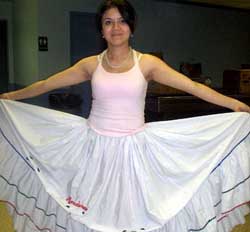
In addition to having an instructor, they employ the internet as a learning tool. Even though they have a repertoire of 16 to 20 dances, they say that they are still learning aspects of the music. The dance steps are not difficult or elaborate but they become so as a choreographed group. In addition to performing the dances, the group has also assumed a cultural education role. Before performing, they provide the audience with an explanation of the dance to help them understand what they are viewing and to help them connect to the heritage. The audience reaction is often instant and the shouts from the dancers, which are part of the performance, help energize both the participants and the audience.
Beyond the desire to maintain and promote traditional Honduran dance, Teresa echoes Argentina Colomer's desire to get involved with young people. She wants to use the music and dances to keep the youth "in positive activities." Ronald adds that the group is good for cultural relations; that Hondurans "have a wider culture and provide talent to the community. It is a way to show people that we are more than workers or criminals." Belinda, a history and arts major at the University of New Orleans, says that being exposed to the costumes and stories behind them made her want to learn more about her culture. It increased her pride in her heritage as a New Orleans-born Honduran.
Assimilation, Heritage, and Post-Katrina Immigration
Because of the Spanish colonial and American influences, Honduran heritage is one of adaptation. Ronald Avila describes the challenges faced with "knowing what it is to be Honduran." He explains that the United Fruit Company created a strong cultural, social, political, and economic connection between Honduras and the United States, with New Orleans being central. As a result, the United States influenced the culture of people in Honduras making it seem more American than other Latino countries. This influence helped ease the assimilation of Hondurans who moved to the New Orleans area.
Over the years of immigration, Hondurans did not establish a distinct neighborhood like many other immigrants. Before Hurricane Katrina, Hondurans lived in Jefferson, Orleans, St. Bernard, and Plaquemines Parishes. Some apartment complexes were identified as Honduran communities for recent immigrants, but there is no identified Honduran section of the region. Like all segments of the population of Southeast Louisiana, the Honduran community was greatly affected by Hurricanes Katrina and Rita. Some of the complexes that provided housing to newer arrivals were demolished and many residents did not return to the area. The most recent wave of Honduran immigrants came after the destruction of Honduras by Hurricane Mitch in 1998. The participants report that many Hondurans left the New Orleans region after Hurricane Katrina. Those who left have since been replaced by the migrant laborers who came to the city in the aftermath. This last migration comprises Latino immigrants from throughout Central America as well as some South American countries. These new residents have helped increase the awareness, appreciation, and extent of Latino culture.
The New Orleans Honduran community is largely composed of people who identify themselves as New Orleanians but who have maintained their Honduran heritage through language and food. All of the Hondurans who participated in this project describe their social networks as diverse and encompassing different nationalities rather than only Honduran. Honduran people expressed pride in their heritage but also that they are part of a larger Central American community. Prior to Hurricane Katrina, the Honduran consulate was active and regularly hosted or sponsored Honduran cultural events. Today, Latino events bring a cross-section of people together, including North Americans.
Throughout the region, the Honduran presence is obvious. Spanish language newspapers are abundant, directories feature Honduran business leaders, and Honduran restaurants are accessible. What is also apparent is that the pre-Katrina Honduran population realizes the depth of cultural loss that came with establishing deep roots in the New Orleans area. Ronald Avila concluded that "there is a sentiment that the Latin nationalities blend together." He believes that while Hondurans have had a strong presence in New Orleans, they have not had a strong voice for a long time because the older immigrants have assimilated. Today, it is the younger generation that is resurrecting traditions. This is enhanced by the new waves of immigration arriving in the area and supported by a few older immigrants intent on teaching the ways. Considering that Honduras is the third poorest country in the western hemisphere and that the United States remains Honduras' primary trading partner, the social links between the two places will likely continue for generations. As new generations arrive, Honduran food, language, song, and dance traditions will continue to be a part of life in New Orleans.


